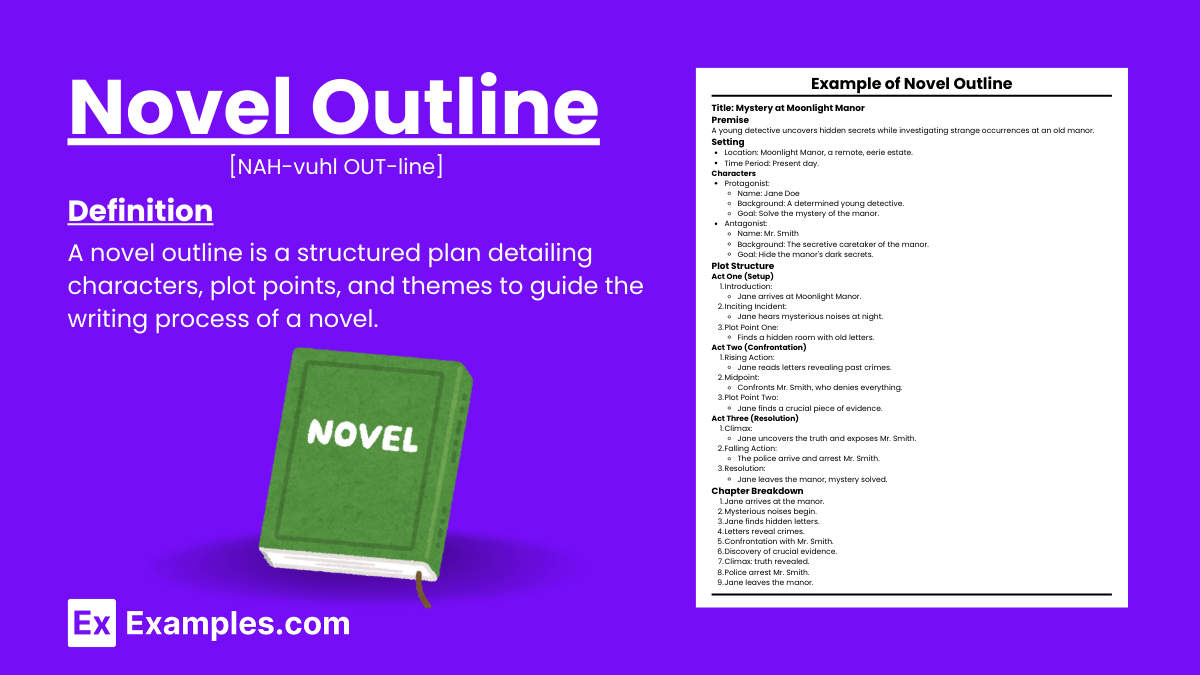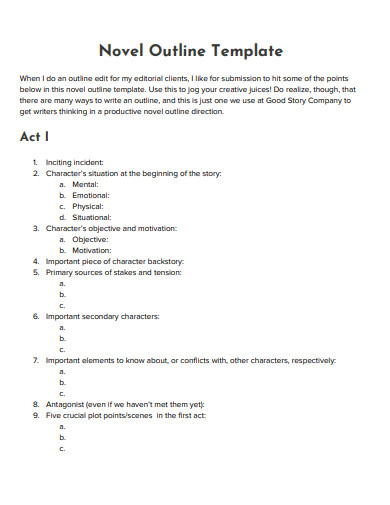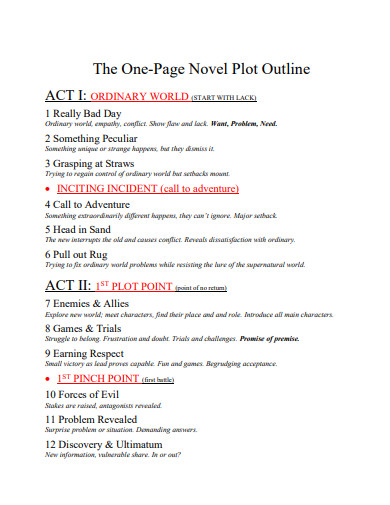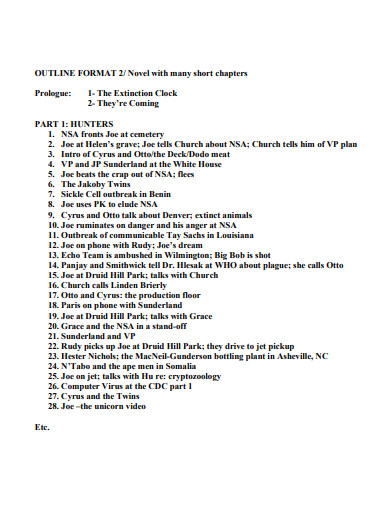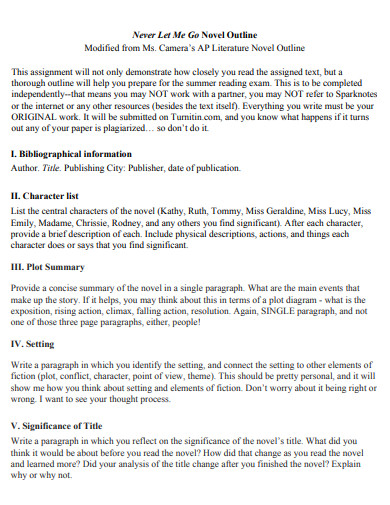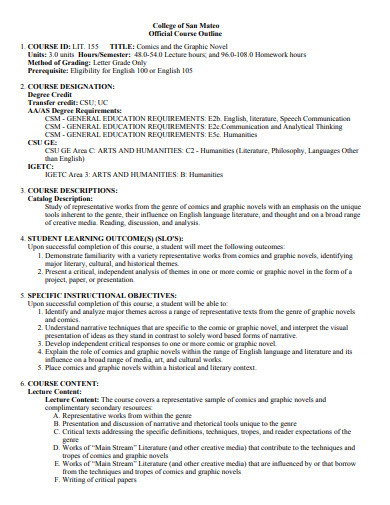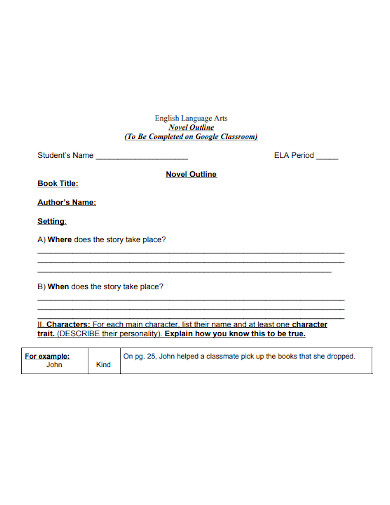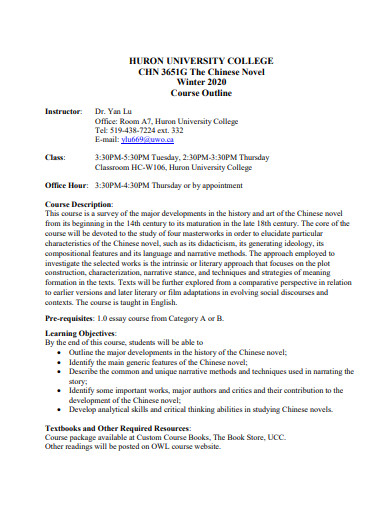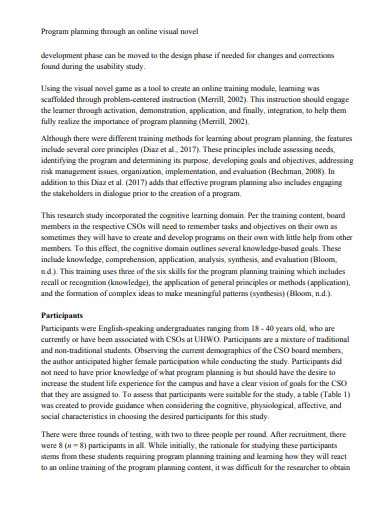10+ Novel Outline Examples to Download
You may spend a lot of time thinking about how to start writing your very first novel. You may envision that it should be pleasing and exhilarating to read. What genre would you prefer to write? Is it some kind of a romantic novel, a science fiction, horror, crime or fantasy? It is up for you to decide. Before you start writing a story, you must need a novel outline that would guide you in making a perfect novel that you’ve been wishing for.
What is a Novel Outline?
A literature review outline is a structured plan that helps organize research sources and findings. It typically includes an introduction, search strategy, theoretical framework, review of literature categorized by themes, critical analysis, discussion and synthesis, conclusion, references, and appendices if applicable. This structure ensures a comprehensive and coherent summary of existing research on a specific topic.
Examples of Novel Outline
1. Three-Act Structure Outline
Title: The Lost Kingdom
Act One (Setup)
- Introduction:
- Setting: Modern-day London.
- Protagonist: Alex Turner, a young archaeologist.
- Conflict: Alex discovers a mysterious artifact linked to a lost kingdom.
- Inciting Incident:
- Alex is contacted by an anonymous source who claims to know the artifact’s secrets.
- Plot Point One:
- Alex decides to investigate, leaving for a remote island where the kingdom is rumored to be.
Act Two (Confrontation)
- Rising Action:
- Challenges: Alex faces natural obstacles and rival treasure hunters.
- Allies: Meets Sarah, a local historian, who becomes an ally.
- Enemies: Rival archaeologist Dr. Blackwood, who wants the artifact for himself.
- Midpoint:
- Alex and Sarah discover an ancient map leading to the kingdom.
- They face betrayal from a supposed ally.
- Plot Point Two:
- Alex is captured by Dr. Blackwood, who steals the map.
Act Three (Resolution)
- Climax:
- Alex escapes and confronts Dr. Blackwood in the lost kingdom’s ruins.
- A battle ensues, revealing the kingdom’s secrets.
- Falling Action:
- Dr. Blackwood is defeated, and the kingdom’s treasure is found.
- The artifact’s true purpose is revealed.
- Resolution:
- Alex returns to London with newfound knowledge and a sense of accomplishment.
- He and Sarah decide to continue their adventures together.
2. Snowflake Method Outline
Title: Mystery of the Moonlit Manor
Step 1: One-Sentence Summary
- A young detective must solve the mystery of a haunted manor before the ghostly occurrences turn deadly.
Step 2: One-Paragraph Summary
- Introduction: Emma Brooks, a young detective, is called to investigate strange occurrences at Moonlit Manor.
- Conflict: As she delves deeper, she uncovers a series of murders linked to the manor’s dark past.
- Climax: Emma confronts the ghost responsible for the hauntings.
- Resolution: She uncovers the truth, freeing the spirits trapped in the manor.
Step 3: Character Summaries
- Emma Brooks: Determined, intelligent, haunted by her past.
- Mr. Harrison: The manor’s caretaker, hiding secrets.
- The Ghost: A tormented spirit seeking justice.
Step 4: Expanded Plot Summary
- Beginning: Emma arrives at Moonlit Manor.
- Middle: She discovers hidden rooms and old letters revealing past crimes.
- End: Emma confronts the ghost, solves the mystery, and brings peace to the manor.
Step 5: Scene List
- Emma arrives at the manor.
- Introduction to Mr. Harrison.
- First ghostly encounter.
- Discovering hidden rooms.
- Reading old letters.
- Confronting the ghost.
- Solving the mystery.
- Bringing peace to the manor.
3. Chapter-by-Chapter Outline
Title: Echoes of the Past
Chapter 1: Arrival
- Summary: Detective John Miller arrives in a small town to investigate a missing person case.
- Key Points: Introduction to John, the town, and the case.
Chapter 2: First Clues
- Summary: John finds the missing person’s diary, hinting at a hidden treasure.
- Key Points: Diary discovery, clues about the treasure.
Chapter 3: Uncovering Secrets
- Summary: John interviews townspeople, uncovering secrets about the town’s history.
- Key Points: Interviews, town’s dark history.
Chapter 4: The Antagonist
- Summary: John meets a local thug, Mark, who is also after the treasure.
- Key Points: Introduction to Mark, conflict between John and Mark.
Chapter 5: Hidden Maps
- Summary: John discovers a hidden map in the library.
- Key Points: Map discovery, planning the next steps.
Chapter 6: The Chase
- Summary: John and Mark race to find the treasure first.
- Key Points: Chase scenes, escalating tension.
Chapter 7: Confrontation
- Summary: John confronts Mark in an old cave where the treasure is hidden.
- Key Points: Final showdown, resolving the conflict.
Chapter 8: Resolution
- Summary: John recovers the treasure and solves the missing person case.
- Key Points: Treasure found, case closed, John leaves the town.
Novel Outline Templates & Samples in PDF
1. Novel Outline Template
2. One-Page Novel Plot Outline
3. Novel Outline Format
4. Sample Novel Outline
5. Official Course Outline
6. Novel Outline Example
7. Novel Course Outline in PDF
8. Online Visual Novel Outline
Types of Novels
Novels come in various genres, each offering unique experiences and perspectives. Here are some of the most popular types of novels:
1. Literary Fiction
Literary fiction focuses on character development, themes, and style. It often explores deep human experiences and emotions, prioritizing prose and thematic depth over plot.
Examples:
- To Kill a Mockingbird by Harper Lee
- Pride and Prejudice by Jane Austen
2. Mystery
Mystery novels revolve around solving a crime or uncovering secrets. They keep readers engaged with suspenseful plots, clues, and red herrings.
Examples:
- The Girl with the Dragon Tattoo by Stieg Larsson
- Murder on the Orient Express by Agatha Christie
3. Science Fiction
Science fiction explores futuristic concepts, advanced technology, and space exploration. It often delves into the impact of science and technology on society.
Examples:
- Dune by Frank Herbert
- Neuromancer by William Gibson
4. Fantasy
Fantasy novels feature magical elements, mythical creatures, and imaginary worlds. They often involve quests and battles between good and evil.
Examples:
- Harry Potter series by J.K. Rowling
- The Lord of the Rings by J.R.R. Tolkien
5. Romance
Romance novels focus on love and relationships, often featuring a central love story with an emotionally satisfying ending.
Examples:
- Pride and Prejudice by Jane Austen
- The Notebook by Nicholas Sparks
6. Historical Fiction
Historical fiction is set in the past and often incorporates real historical events or figures into the narrative, blending fact with fiction.
Examples:
- The Book Thief by Markus Zusak
- All the Light We Cannot See by Anthony Doerr
7. Thriller
Thriller novels are characterized by fast-paced plots, high stakes, and constant tension. They often involve espionage, crime, or psychological elements.
Examples:
- The Da Vinci Code by Dan Brown
- Gone Girl by Gillian Flynn
8. Horror
Horror novels aim to evoke fear, dread, and shock in readers. They often feature supernatural elements, monsters, or psychological terror.
Examples:
- It by Stephen King
- The Haunting of Hill House by Shirley Jackson
9. Young Adult (YA)
Young Adult novels are targeted at teenagers and young adults. They often explore coming-of-age themes, identity, and personal growth.
Examples:
- The Hunger Games by Suzanne Collins
- The Fault in Our Stars by John Green
10. Dystopian
Dystopian novels depict societies characterized by oppression, totalitarian regimes, or environmental disasters. They often explore themes of freedom and rebellion.
Examples:
- 1984 by George Orwell
- The Handmaid’s Tale by Margaret Atwood
11. Adventure
Adventure novels are driven by a sense of excitement and exploration. They often feature journeys, discoveries, and daring feats.
Examples:
- Treasure Island by Robert Louis Stevenson
- The Adventures of Huckleberry Finn by Mark Twain
12. Detective Fiction
Detective fiction revolves around a detective, professional or amateur, solving a mystery or crime through investigation and logical deduction.
Examples:
- Sherlock Holmes series by Arthur Conan Doyle
- The Maltese Falcon by Dashiell Hammett
13. Magical Realism
Magical realism blends magical elements with a realistic setting, often to explore complex social and political issues.
Examples:
- One Hundred Years of Solitude by Gabriel García Márquez
- Beloved by Toni Morrison
14. Graphic Novels
Graphic novels use a combination of illustrations and text to tell a story. They can span various genres, from superhero tales to memoirs.
Examples:
- Maus by Art Spiegelman
- Watchmen by Alan Moore and Dave Gibbons
15. Historical Romance
Historical romance combines elements of historical fiction and romance, often set in a specific historical period with a focus on a romantic plot.
Examples:
- Outlander by Diana Gabaldon
- Poldark series by Winston Graham
Elements of a Novel Outline
Creating a detailed outline is an essential step in writing a novel. It helps organize thoughts, develop characters, and plot the narrative. Here are the key elements to include in a novel outline:
1. Title
- Working Title: Give your novel a working title to encapsulate the main theme or central idea.
2. Premise
- Brief Summary: Write a concise summary of your novel’s main idea, highlighting the protagonist, conflict, and stakes.
3. Setting
- Location: Describe the primary and secondary locations where the story takes place.
- Time Period: Specify the time period, including historical context if relevant.
- World-Building: Outline the rules, cultures, and societal norms if your novel involves a fictional or fantastical world.
4. Characters
- Protagonist: Detail your main character, including their background, personality, and motivations.
- Antagonist: Describe the main antagonist, their goals, and how they oppose the protagonist.
- Supporting Characters: List other significant characters, their roles, and their relationships with the protagonist and antagonist.
5. Plot Structure
- Introduction/Exposition: Set the scene, introduce main characters, and establish the story’s context.
- Inciting Incident: Identify the event that sets the main plot in motion.
- Rising Action: Outline the series of events that build tension and develop the story’s central conflict.
- Climax: Detail the turning point or the most intense moment of the story.
- Falling Action: Describe the events that follow the climax and begin to resolve the story’s conflict.
- Resolution/Denouement: Explain how the story concludes and the fate of the characters.
6. Themes
- Central Themes: Identify the main themes or messages you want to convey through your novel.
- Sub-Themes: Note any secondary themes that will be explored.
7. Chapter Breakdown
- Chapter Summaries: Provide a brief summary of what happens in each chapter, including key events, character development, and plot progression.
8. Conflict
- Internal Conflict: Describe the protagonist’s internal struggles and how they evolve throughout the story.
- External Conflict: Outline the external obstacles and challenges the protagonist faces.
9. Point of View
- Narrative Perspective: Decide whether the story will be told from the first person, second person, or third person point of view.
- Narrator: Describe the narrator’s voice, reliability, and any biases.
10. Tone and Style
- Tone: Determine the overall tone of the novel (e.g., serious, humorous, dark).
- Writing Style: Outline the stylistic choices, such as language level, pacing, and use of literary devices.
11. Symbols and Motifs
- Symbols: Identify any recurring symbols that will add deeper meaning to the story.
- Motifs: Note any motifs that will recur throughout the novel to reinforce themes and character development.
12. Research
- Necessary Research: List any topics you need to research to ensure accuracy and authenticity in your novel.
- Sources: Mention potential sources of information, such as books, articles, or interviews.
13. Timeline
- Chronological Order: Create a timeline of events to maintain consistency and track the progression of the plot and character arcs.
14. Scene List
- Scenes: Break down each chapter into individual scenes, detailing the setting, characters involved, and key actions.
15. Additional Notes
- Miscellaneous: Include any other important notes, ideas, or reminders relevant to your novel.
Different Methods for Outlining a Novel
Outlining a novel can help writers structure their ideas, develop characters, and plan the plot. Here are several popular methods for outlining a novel:
1. The Snowflake Method
The Snowflake Method involves starting with a simple idea and expanding it step by step into a detailed outline.
Steps:
- One-Sentence Summary: Create a one-sentence summary of your novel.
- Expand to One Paragraph: Write a paragraph describing the story setup, major events, and ending.
- Character Summaries: Develop a summary for each main character, including their goals, conflicts, and growth.
- Expand to One Page: Write a one-page synopsis of the story, expanding on the paragraph summary.
- Character Descriptions: Write a full-page description for each main character.
- Expand to Four Pages: Expand the one-page synopsis to four pages, detailing each major plot point.
- Scene List: Create a list of scenes, summarizing what happens in each one.
2. The Three-Act Structure
The Three-Act Structure divides the story into three parts: Setup, Confrontation, and Resolution.
Steps:
- Act One (Setup): Introduce characters, setting, and the main conflict. End with the inciting incident.
- Act Two (Confrontation): Develop the story’s main conflict through rising action. Introduce subplots and character development. End with the climax.
- Act Three (Resolution): Resolve the conflict, tie up loose ends, and conclude the story.
3. The Hero’s Journey
The Hero’s Journey outlines the protagonist’s adventure through specific stages, often used in fantasy and adventure novels.
Stages:
- Ordinary World: Introduce the hero’s normal life.
- Call to Adventure: Present the challenge or quest.
- Refusal of the Call: Show the hero’s hesitation.
- Meeting the Mentor: Introduce a mentor who guides the hero.
- Crossing the Threshold: The hero enters the new world.
- Tests, Allies, Enemies: The hero faces challenges and makes allies and enemies.
- Approach to the Inmost Cave: The hero prepares for a major challenge.
- Ordeal: The hero faces the biggest challenge yet.
- Reward: The hero earns a reward.
- The Road Back: The hero begins the return journey.
- Resurrection: The hero faces a final test.
- Return with the Elixir: The hero returns home transformed.
4. The Save the Cat Beat Sheet
The Save the Cat Beat Sheet, developed by Blake Snyder, is a detailed plot structure with specific “beats” or plot points.
Beats:
- Opening Image: Present the initial snapshot of the hero’s world.
- Theme Stated: Hint at the story’s theme.
- Set-Up: Introduce main characters and the world.
- Catalyst: Inciting incident that changes the hero’s life.
- Debate: The hero debates what to do next.
- Break into Two: The hero decides to act and enters Act Two.
- B Story: Introduce a subplot, often a love story.
- Fun and Games: The main premise of the story unfolds.
- Midpoint: A major event that changes the direction of the story.
- Bad Guys Close In: Obstacles intensify.
- All Is Lost: The hero hits rock bottom.
- Dark Night of the Soul: The hero reflects and decides to fight back.
- Break into Three: The hero discovers a solution.
- Finale: The hero confronts the main conflict and resolves it.
- Final Image: Show the hero’s new life.
5. The Mind Map
Mind mapping is a visual method that involves brainstorming ideas and organizing them in a diagram.
Steps:
- Central Idea: Write the central idea or theme in the center of a page.
- Branches: Create branches for main characters, settings, and plot points.
- Sub-Branches: Add details and subplots to each branch.
- Connections: Draw lines to show relationships and connections between elements.
6. The Chapter-by-Chapter Outline
This method involves outlining the novel chapter by chapter, detailing what happens in each one.
Steps:
- Chapter Titles: Write tentative titles for each chapter.
- Summary: Write a brief summary of the main events in each chapter.
- Detailed Breakdown: Expand each summary into a more detailed outline, including key scenes, character development, and plot points.
7. The Index Card Method
The Index Card Method involves writing scenes or plot points on index cards and arranging them to find the best sequence.
Steps:
- Write Scenes: Write each scene or plot point on an index card.
- Organize Cards: Arrange the cards in the order of your story.
- Rearrange: Move cards around to experiment with different sequences and find the most effective structure.
- Detail: Add more details to each card as needed.
Steps to Outline a Novel
Outlining a novel helps organize your ideas, develop characters, and plan the plot. Here are the steps to outline a novel effectively:
1. Brainstorm Ideas
- Write Down Ideas: Jot down any ideas you have about the story, characters, and setting.
2. Create a Premise
- One-Sentence Summary: Write a single sentence that captures the main idea of your novel.
- Expand: Add a few sentences to describe the main character, conflict, and stakes.
3. Develop Characters
- Main Characters: List your main characters and write a brief description for each, including their goals and conflicts.
- Supporting Characters: Add other important characters and their roles.
4. Choose a Setting
- Where and When: Decide where and when your story takes place. Write a few sentences describing the setting.
5. Outline the Plot
- Beginning: Describe how your story starts. Introduce the main characters and setting.
- Middle: Outline the major events and challenges your characters face.
- End: Explain how the story resolves and what happens to the characters.
6. Break into Chapters
- Chapter List: Make a list of chapters. For each chapter, write a short summary of what happens.
7. Plan Key Scenes
- Important Scenes: Identify the most important scenes in your story. Write a brief description of each.
8. Add Themes
- Main Themes: Note the main ideas or messages you want to convey.
9. Review and Adjust
- Check for Gaps: Make sure your story flows well and fills any gaps.
- Refine: Make adjustments to improve the story’s clarity and coherence.
10. Start Writing
- Follow the Outline: Use your outline to guide you as you write your novel.
Why should I outline my novel?
Outlining helps organize your thoughts, ensures a cohesive story, and makes the writing process more efficient.
What is the Snowflake Method?
The Snowflake Method expands a simple idea step by step into a detailed outline, starting with a one-sentence summary.
How detailed should my outline be?
The level of detail varies. Some writers prefer detailed chapter summaries, while others use broad strokes to guide the plot.
Can I change my outline while writing?
Yes, outlines are flexible. Adjust your outline as your story and characters develop during the writing process.
What is the Three-Act Structure?
The Three-Act Structure divides the story into Setup, Confrontation, and Resolution, ensuring a balanced and engaging narrative.
How do I outline character arcs?
Include character goals, motivations, and changes they undergo throughout the story. Detail their growth and challenges.
What are plot points?
Plot points are key events that drive the story forward, including the inciting incident, climax, and resolution.
How can I use mind mapping for outlining?
Mind mapping involves brainstorming ideas visually, creating branches for characters, settings, and plot points to see connections.
What is the Index Card Method?
Write scenes or plot points on index cards and arrange them to find the best sequence for your story.
Do I need an outline for every novel genre?
Outlines are beneficial for all genres, helping maintain structure and coherence, though the method may vary by genre.



